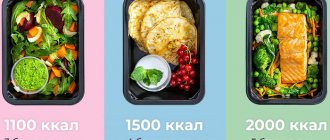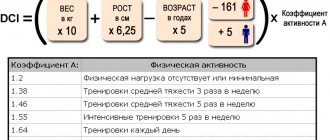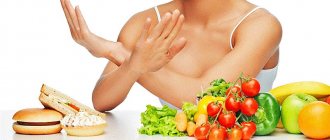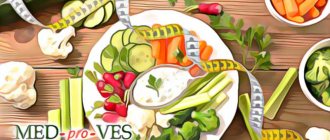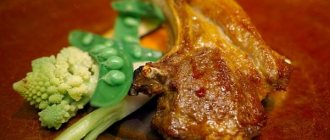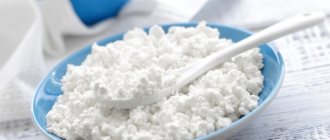Calorie content is a unit of measurement of the energy value of food, accumulated in components such as proteins, carbohydrates and fats, expressed in calories (cal) or kilocalories (kcal). Many modern representatives of the fair half of humanity, and even men, regularly count calories in order to properly plan their diet for effective weight loss and eliminate extra centimeters in the most problematic areas of the body (waist, hips, butt and abdomen).
Calories are also counted to gain muscle mass and total body weight, which is mostly found in people who are professionally involved in sports. But hardly anyone has ever thought about what calories themselves are and what significance they have for the life of the body. In the materials of the presented review, we will take a closer look at what calories and kilocalories are, how they differ and what their benefits for human health are.
What is the difference
Those who monitor body weight and count kcal do not really think about what this means. The reduction in calories is carried out actively, without particularly going into where it came from and where it went.
And most importantly, without thinking about it: calories and kilocalories - what is the difference between them:
- The calorie content of the product is always indicated on the packaging in kilocalories. If it says “N kcal”, you can’t believe it, all products have a calorie content, even the smallest one, and this sign is the ignorance of the manufacturer.
- To be clear, how many calories are in a kilocalorie? 1 kcal = 1000 calories.
- Exercise equipment in the gym often displays incorrect information about the calories burned on it. The measurement is made in kilocalories.
It must be remembered that products with zero or negative kcal do not exist in nature, no matter how their manufacturers claim in their advertisements.
Video
Why does the body need kcal?
Energy is required for normal human functioning. To move, breathe, circulate blood through the vessels, and even rest. Energy enters the body from the outside, with food. How much a person eats, so much energy will be generated.
How many kilocalories are contained in one gram of food components:
- carbohydrates – 4 kcal;
- proteins – 4 kcal;
- fats – 9 kcal.
Human food consists of these ingredients. Knowing the weight of the product in a dish, you can easily calculate the calories received from food.
The most popular breakfast is oatmeal. In 100 g there will be so many calories:
- Fat 6 g * 9 kcal = 54 kcal.
- Protein 12 g * 4 kcal = 48 kcal.
- Carbohydrates 51 g * 4 kcal = 204 kcal.
It turns out that 100 g of oatmeal contains 306 kcal. Metabolism will dispose of the received energy as follows: proteins will be converted into amino acids, carbohydrates into glucose and other simple sugars, and fats will be converted into glycerol and fatty acids required by our body.
Video
The importance of water for humans
Water is needed for most body functions, including:
- Maintain the health and integrity of every cell in the body.
- Blood could move through the blood vessels.
- Help eliminate metabolic byproducts in the body, excess electrolytes (such as sodium and potassium) and urea, which is a waste product created when dietary protein is processed.
- Regulate body temperature by sweating.
- Moisten mucous membranes such as the lungs and mouth.
- Lubricate and restore joints.
- Reduce the risk of cystitis by keeping your bladder free of bacteria.
- Help digestion and prevent constipation.
- Moisturize your skin to maintain its texture and appearance.
- Transport nutrients and oxygen to cells.
- Serve as a shock absorber inside the eyes, spinal cord and in the amniotic sac surrounding the fetus during pregnancy.
Where do they go then?
The body processes complex components of foods into simple ones, and then they go:
- Amino acids - from them muscle tissue, some hormones and enzymes are formed.
- Glucose is used to nourish cells. Its excess is deposited in “storage areas”: muscle and liver cells.
- Fats are used as fuel. Some of them go to the liver and are processed into cholesterol. When too much of it is received, it is deposited in the subcutaneous layer. These are exactly the fats that all females and a sufficient number of the stronger sex struggle with.
How is caloric intake distributed if you need to gain weight:
- Proteins – 30% of the total diet.
- Fats – 35% of food.
- Carbohydrates – 45% of the diet.
If you want to lose weight, then the percentage component changes:
- Proteins – 30% of the total products.
- Fats – 20% of products.
- Carbohydrates – 50%.
This is important: The amount of kcal for a person’s daily requirement should be calculated individually. As a result, the amount of proteins, fats and carbohydrates will change significantly.
How to calculate the calorie content of foods
Quite often, young girls try to lose weight by reducing calories. At the same time, they maintain their usual diet, just monitor the balance.
Video
The important principles in this method of losing weight remain:
- The amount of kilocalories eaten per day should be equal to or less than the amount of energy consumed during the day.
- It does not matter what products are used. It is important not to overstep the target limit and not to eat too much.
- You cannot significantly reduce the daily kcal norm so as not to provoke a malfunction of the systems and not get any diseases.
The calorie content of foods is calculated as shown in the example of oatmeal:
- Ingredients for preparing porridge: 200 g of cereal, a liter of milk, 2 tablespoons of sand, a pinch of salt, a spoon of cow butter.
- Calorie content: cereal – 732 kcal, milk – 640 kcal, sand – 199 kcal, butter – 149.6 kcal, salt – 0 kcal.
- The final result of the resulting porridge is 1720.6 kcal.
The numerical index of the calorie content of a product is available in a table that can be found on the Internet or in specialized literature.
When calculating, you need to take into account some nuances:
- The indicator for boiled cereals and pasta is three times less than the same product in its raw form.
- The weight of boiled meat decreases quite significantly, but rice, on the contrary, becomes larger.
- Dried foods (fruits, mushrooms, berries and crackers) have a much higher calorie content than the same foods in their original form. Here you need to calculate in this way: first, calculate the indicator x - the difference in the weight of the dried product, and then multiply the indicator from the table by x.
- In soup, you need to calculate not only those products that are included in the broth, but also seasonings, sour cream and everything that is usually added directly to the plate.
Nutrition must be monitored carefully, taking maximum care to ensure that healthy foods enter the body.
Does cold water burn calories?
It is known that water contains no calories. Do they burn in the body when heating ice water? The answer is yes. But when calculating, you can see that the numbers are insignificant: to heat 500 ml of water from 0 degrees to body temperature, the body will burn only 17 kcal. Against the background of the required daily energy consumption of 400-600 kcal, this is not an enough amount for noticeable weight loss. Even the theory of drinking “8 glasses of water” every day will allow you to spend only 70 kcal on heating an ice-cold drink! At the same time, the chance of catching a cold will increase several times. Cold water is not approved by experts as a substitute for low-calorie nutrition and exercise.
How to calculate your daily caloric intake
To determine calorie content, you need to take into account some indicators:
- Metabolism (OM). It is affected by work schedule, physical activity, and nutrition. OB is calculated as follows: weight multiplied by 20 kcal.
- Age. How to calculate: for every 10 years after age 20, reduce by 2%.
- Floor. Typically, males require more calories.
- Rhythm of life. The percentage of activity is calculated: inactive - 20%, sedentary with little activity (going to the store, cleaning, walking, etc.) - 30%, average - 40%, high (sports, physical work) - 50%.
- Physical activity (PA) is calculated as follows: OB needs to be multiplied by the percentage of the rhythm of life.
- Percentage of energy during food digestion (PEPP). It is determined as follows: (FA is summed with OB) and multiplied by 10%.
Video
The daily intake of kcal is equal to – PEPP + FA + OB. The final indicator must be adjusted to your age; this is to subtract 2% from the result for the 10 years after the 20-year mark. If the total consumption rate is calculated for weight loss, then the result should be clarified: the daily calorie rate from which is subtracted (weight multiplied by 7 kcal).
Please note: It is necessary to take into account the energy needs of each person individually. Children and adults will have different meanings. Athletes and pregnant women should increase their calorie intake.
Is it possible to drink beer and lose weight?
Many people associate regular beer consumption with the appearance of a “beer belly” and the accumulation of excess weight, and over a short period of time. But this opinion is wrong.
Please note: It is not the intoxicating drink itself that contributes to the accumulation of fat in the body, but the food that a person uses as a snack.
People don’t notice how much croutons, chips, crackers, cheeses, ribs, fish and much more they consume along with hops. All this has a very high calorie content. The drink itself is not considered a high-calorie product. One bottle is equivalent to a standard chocolate bar. Some nutritionists even offer people several types of beer diets that promote weight loss.
Video
Beer, if it is natural and of high quality, contains certain ingredients that help speed up metabolism, which also has a positive effect on the process of losing weight.
How much beer can you drink while losing weight?
If a decision has been made to use a low-alcohol product as an ingredient in a weight loss menu, then its dosage should not exceed 500 ml per day. This will help you lose weight if you just give up any types of snacks to go with it, especially fried, salty, smoked foods.
Low and high calorie foods
Which foods have many or few calories? This is affected by the chemical content. The lowest calorie foods are those whose energy value is less than 40 kcal per 100 g.
Which foods are low in calories:
- Vegetable products: cucumbers, lettuce, greens, garlic, sweet peppers, any onions, beets.
- Fruits and berries: citrus fruits, blackberries, strawberries, quince, cherries, pineapple, cherry plum, lingonberries, kiwi, apple, pomegranates and raspberries.
- Meat products: chicken, rabbit, lean beef, kidneys.
- Fish products: pollock, hake, blue whiting, flounder, shrimp, smelt and other types of river fish.
- Dairy products: all, only low fat.
- From sweets: marshmallows and marshmallows, marmalade.
- From flour - rye bread.
Those foods that have a high calorie content are those that have from 500 to 900 kcal per 100 g. Eating them is unsafe for your figure.
Video
These products include:
- Any types of oils.
- Pork is fatty, lard.
- Raw smoked sausages.
- Cakes with cream.
- Nuts of any kind.
- Milk chocolate.
High-calorie foods include alcoholic drinks, and they also cause increased appetite.
Calorie content of 1 liter
Depending on the type of alcoholic product, variety, its nutritional value can vary between 260-480 kcal per 1 liter.
What criteria does the indicator depend on?
The caloric content of beer will be determined by the type and method of its brewing. The natural drink is made from roasted malt or barley, which have a high sugar content. After a while, in order for the characteristic bitter taste to appear, hops are added to it, and yeast is added to start the fermentation processes.
It is fermentation that allows alcohol and carbon dioxide to begin to be released. Since each individual variety can be prepared according to an individual recipe with a specific set of ingredients, the amount of sugar and yeast in each of them can vary significantly. Dark varieties are considered the most nutritious, and soft drinks the least.
Expert opinion
Smirnov Viktor Petrovich Dietitian, Samara
Many healthy eating enthusiasts do not know what calories are. How much energy does a person spend per day? Let's give a simple example. The article provides a table of a one-day menu for a person with a light level of physical activity. It is approximately 2500 kilocalories per day. As you know, one calorie heats 1 gram, or 1 ml, of water by 1 degree. What can 2500 kilocalories, or 2.5 million calories, do? First of all, such an amount of energy, however, purely theoretically, will allow heating 1 gram of water by 2.5 million degrees, and this is the temperature of thermonuclear fusion, which occurs in the depths of the sun and is the source of all the energy received by the Earth.
And here is the second example, more “down to earth”. Two large household buckets occupy a total volume of 24 liters (12 liters each). What can the same daily flow do to this volume of water? Simple calculation: (2500000/24000 ml). As a result, the balance is 104. Thus, the amount of energy consumed per day by a person at a “sedentary” job can boil two full buckets of water. Therefore, a person on a low-calorie diet and trying to lose weight should not complain that he receives very little energy. It is enough to remember these numbers, and it will immediately feel easier for him.
